From family care to future care: Do we have what it takes to look after older S’poreans?
Sign up now: Get ST's newsletters delivered to your inbox
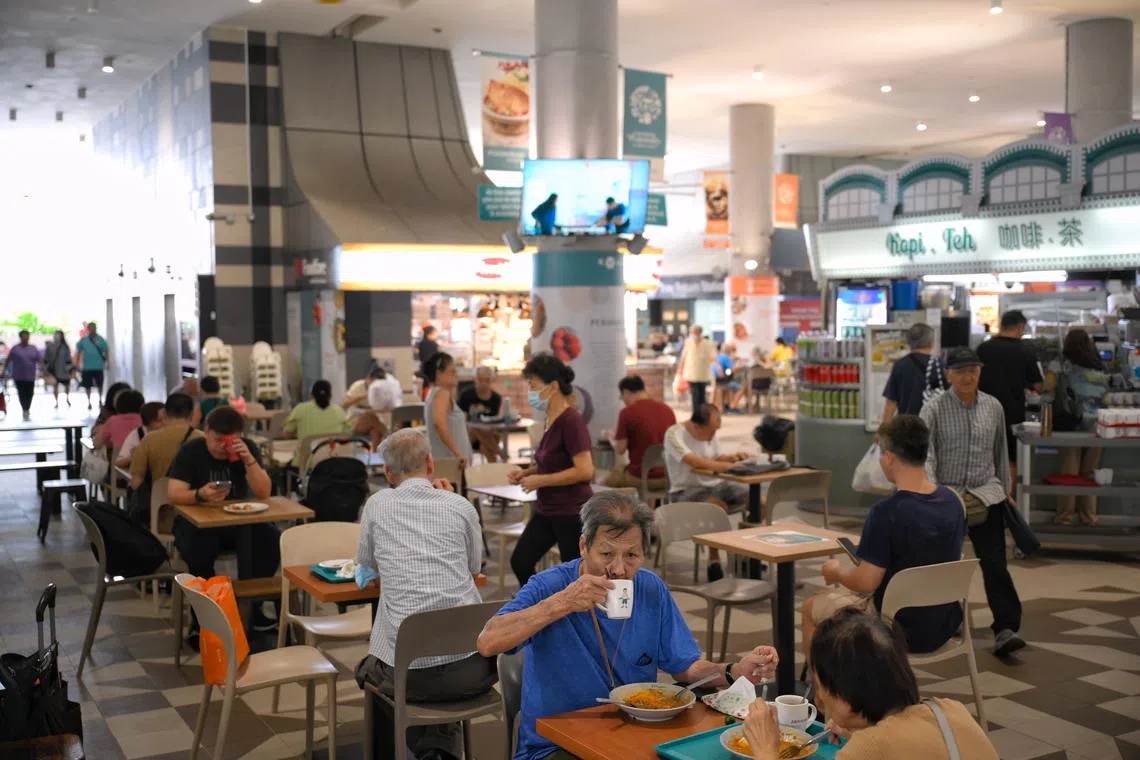
Kampung Admiralty, a pioneering “retirement kampung”, fosters independence while offering support through communal facilities.
ST PHOTO: MARK CHEONG
Follow topic:
The narrative of growing old in Singapore goes something like this: marrying and having children who will then take care of you when you can no longer take care of yourself.
If and when that is not possible, they will check you into a nursing home or hospice where you will stay until you die.
This “traditional” approach to eldercare in Singapore is called “ageing in place”. This philosophy emphasises enabling seniors to remain in their own homes and communities as they age, and delaying moving them into institutional care facilities for as long as possible.
The realities of modern life, however, are testing the limits of this model. Professor Paulin Tay Straughan has been sounding the alarm bells for years.
“We’ve valorised the importance of family, and sometimes we forget to do a pulse check. Are families really taking care of their aged members?” asks the director of the Centre for Research on Successful Ageing. She was also the principal investigator of a project on Successful Ageing in Singapore, Seoul and Shanghai.
The utopia of intergenerational transfer of assistance and adult children taking care of their ageing parents hinges on a specific type of family construct, she says. A single breadwinner along with a full-time housewife who can then dedicate time to become a full-time caregiver to ageing parents.
But that is no longer the predominant type of family in Singapore. In the last population census conducted in 2020, dual-career couples (with both husband and wife employed) constituted the largest group among married couples, with the proportion increasing from 47.1 per cent in 2010 to 52.5 per cent in 2020.
“Who is going to do the caregiving? Who has the time and energy?” asks Prof Straughan.
Adding to the challenge is Singapore’s changing social landscape. The proportion of seniors aged 65 years and above who are single has increased from 4.6 per cent in 2010 to 7.2 per cent in 2020. Those who are married may have children who migrate overseas or live separately from their parents. There are also many seniors who want to live on their own.
In 2023, there were 78,135 seniors aged 65 and above, living alone in Singapore, a marked increase from 58,000 in 2018.
“If you no longer can count on having someone take care of you in your old age, you have to either leave it to chance, or start having a concrete plan that is acceptable to you,” says Prof Straughan.
In the light of such shifts in familial dynamics, alternative living arrangements that cater to a spectrum of needs and preferences, and bridge the gap between independent living and institutional care have sprung up.
Public assisted living options
Retiree Mariam Jumaat, 74, lives in Kampung Admiralty, Singapore’s pioneering “retirement kampung”,
The former hospital porter, who is not married, was living alone for 10 years in a three-bedroom flat in MacPherson after her mother died in 2007. She is the youngest of eight children; her siblings had moved out of the family home after getting married.
“I didn’t want to live in a big flat alone,” she says.
In 2015, she applied for a Build-To-Order (BTO) one-bedroom flat in Kampung Admiralty. Excluding grants, prices for a studio apartment there – which has a lease of 30 years – start from $91,000. Applicants must be aged 55 and above at the time of application, and full payment of the lease has to be made by cash, or Central Provident Fund (CPF) savings, or both.
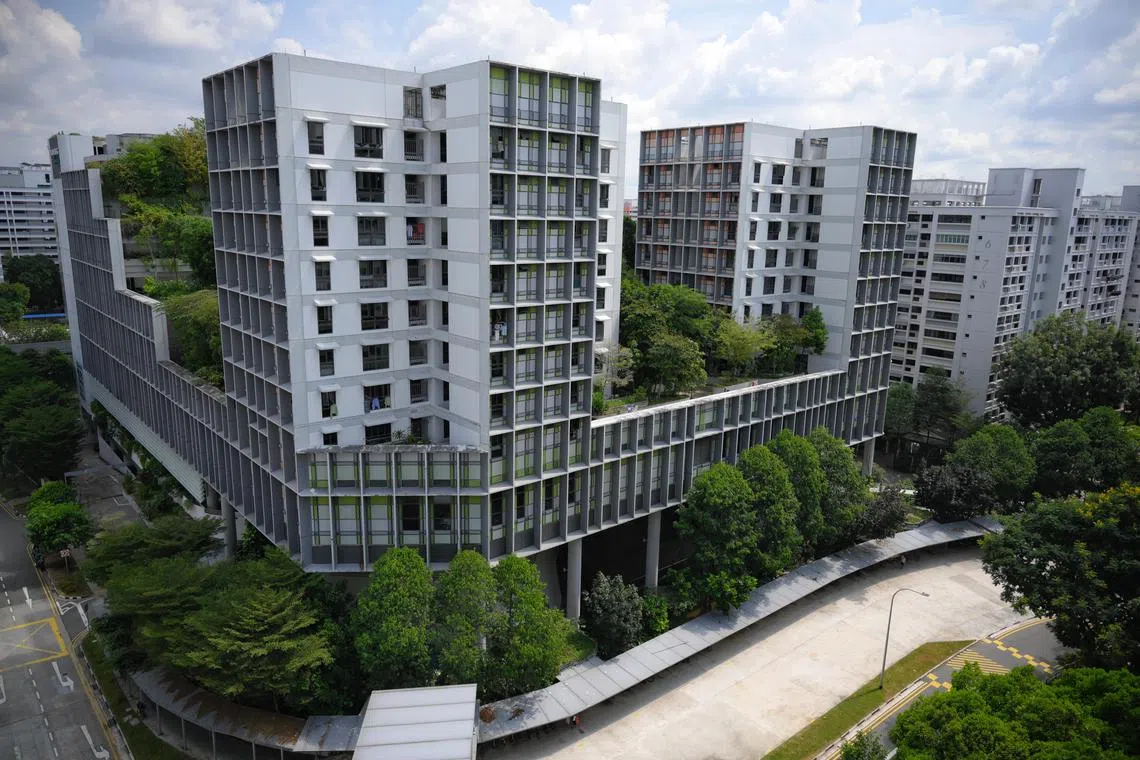
Public housing projects that help seniors living alone to age in place, such as Kampung Admiralty, are in high demand.
ST PHOTO: MARK CHEONG
Of the 103 units, 44 were booked under the Studio Apartment Priority Scheme and the Senior Priority Scheme. These schemes give priority to elderly residents who wish to age in a familiar environment or those who want to live near their married child or parents.
Ms Mariam’s flat was already renovated, with vinyl strip flooring that is slip- and moisture-resistant, with safety features like grab bars in the toilet. In each room, there is an emergency alarm button that, when pressed, will result in her unit number flashing in the lift lobbies, alerting neighbours.
In the lower levels of the two residential blocks, there are facilities such as a hawker centre, a supermarket, and a medical centre that offers specialist outpatient consultations, endoscopy and day surgery procedures.
It has been seven years and Ms Mariam loves living there, and understandably so. It is right next to the MRT station. Getting food from the hawker centre is so convenient that she does not cook at home any more.
She sometimes participates in activities organised by the NTUC Health Active Ageing Centre on the sixth floor.
Every Monday, she joins her 64-year-old neighbour Doris Yuen and her brisk walking group, walking 2.5km around the neighbourhood. When she gets letters from the Government she does not understand, she gets her to explain them to her.
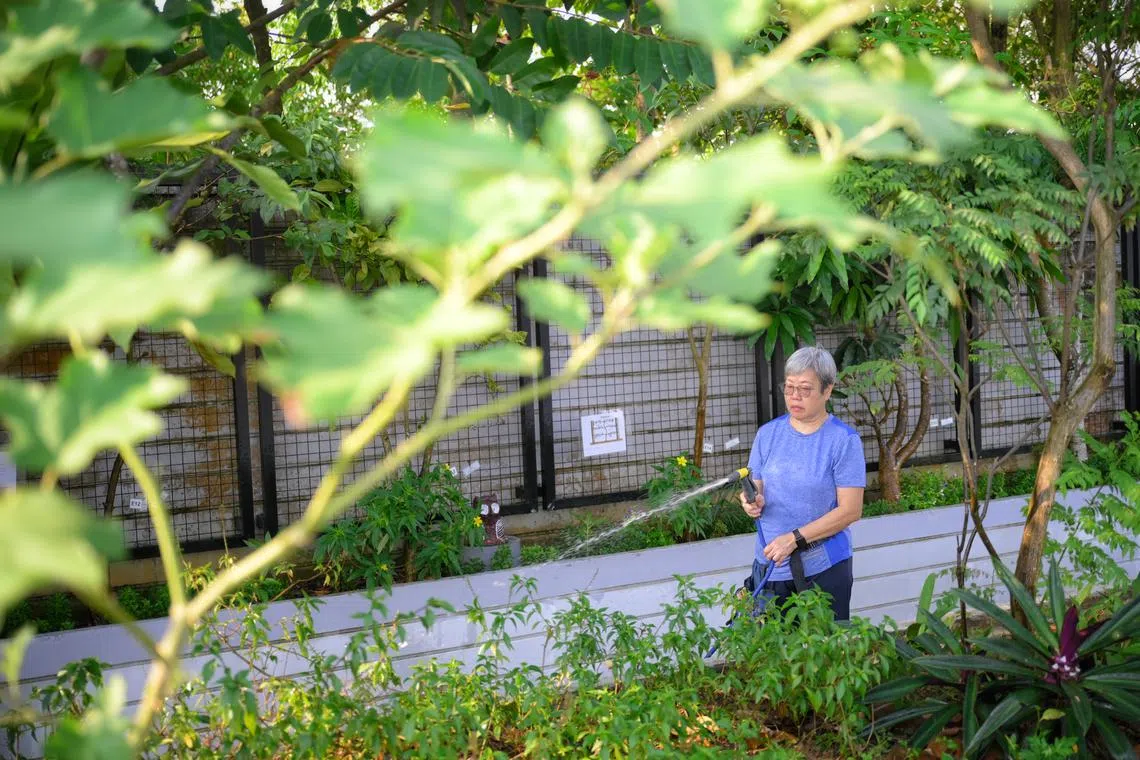
Kampung Admiralty resident Doris Yuen watering plants at the community garden.
ST PHOTO: MARK CHEONG
Ms Mariam wants to live there on her own as long as she can. The idea of living with flatmates is unappealing to her.
“I am fussy. I don’t like it when others are messy and dirty. I much prefer to live alone,” she says.
Public housing projects that help seniors living alone to age in place, such as Kampung Admiralty, are in high demand. When the Housing Board’s second integrated development for seniors, Heart of Yew Tee, was launched in November 2021,
Meanwhile, HDB launched its first assisted living public housing flats
All residents must subscribe to a basic service package, which includes the help of a community manager who can arrange basic health checks, simple home fixes and 24-hour emergency response. Depending on their care needs, residents can also subscribe to services such as shared caregiving, housekeeping and meal-delivery service.
Harmony Village @ Bukit Batok saw a subscription rate of four applicants per unit. Since then, a community care apartment BTO project has been announced in Queensway and another in Bedok.
The catch? Just like any other BTO project, there is a waiting time of at least three years for assisted living public housing today. The wait could well get even longer. Harmony Village @ Bukit Batok was initially slated to be completed in the second quarter of 2024, but this has been pushed back to between September and October 2024 .
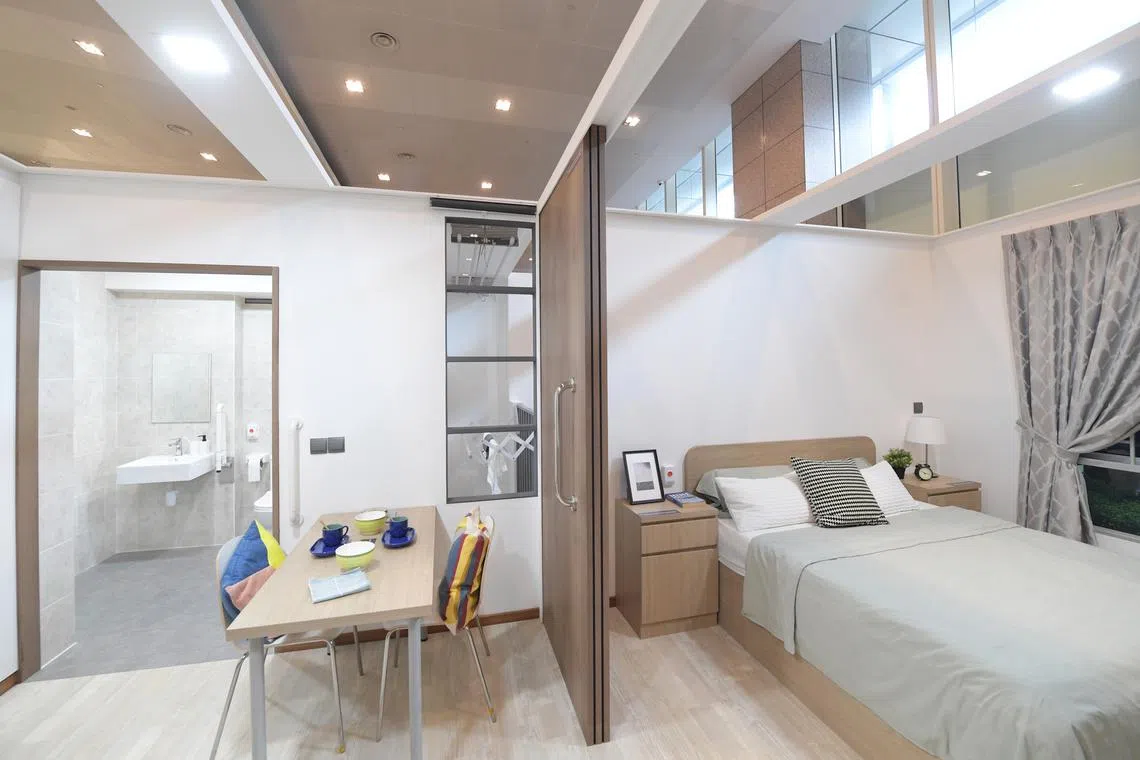
More community care apartment BTO projects have been announced, with locations in Queensway and Bedok.
PHOTO: ST FILE
Private eldercare options
Parallel to these public initiatives, the private sector also offers some eldercare options. One such set-up is situated in a restored two-storey conservation shophouse in Joo Chiat Road.
Joo Chiat Social Club is the brainchild of husband-and-wife team Mariel Chee and Bennett Lee. The intergenerational social club doubles up as an assisted living facility and is currently home to seven seniors aged 67 to 92.
They stay either in a single or twin occupancy room that comes with an en-suite bathroom.
Depending on the type of room and the amount of caregiving needed, monthly fees start from $4,800. Besides boarding, the fees cover meals, laundry and daily housekeeping. The price, however, does not include medication management, transport to medical appointments, and consumables such as diapers and toiletries.
Think of it as a serviced apartment with a rotating shift of professional caregivers. Residents are also automatically enrolled into a social club where they get to participate in weekly fitness as well as social programmes, and craft sessions like rattan-weaving and candle-making.
Excluding the couple, at least three healthcare staff look after the residents. Before admission, Ms Chee works with the seniors and their families to develop a care plan.
Residents who are more independent are free to come and go as they please, with no strict curfew – as long as they inform the staff about where they are going. Every morning, they visit a nearby park to exercise. One resident’s favourite weekly activity is getting his hair washed at a nearby salon.
Adopting a family-based care approach, Mr Lee plans the daily menu and does repairs around the house, while his wife organises the social club activities. They both take the residents out for outings regularly.
Ms Chee has been receiving more inquiries from seniors looking to make assisted living arrangements for themselves. Many are in their 60s and 70s, and still able to live independently for now, but anticipate that at some point, they would need help.
In 2023, Dr Sheena Ramazanu, a research fellow from the Saw Swee Hock School of Public Health, National University of Singapore, led a qualitative study of seniors ageing in the community with Associate Professor Jeremy Lim (primary investigator) and a team of researchers.
Dr Ramazanu says: “Seniors we talked to prefer the homely set-up, and they feel psychologically safe when they have a caregiver with them. Because it is their own home, they feel like they are ageing in place.”
Along Upper Thomson Road stands yet another private eldercare facility, targeted at those for whom money is no object.
With their modern interior decor, floor to ceiling windows facing lush greenery, the rooms at Allium Care Suites are not far from what you would find in a luxury serviced apartment.
The main differences: the bed is a hospital bed with a control panel to tilt it up, the wardrobe comes with a pull-out rail, and the basin in the toilet is height-adjustable and wheelchair user-friendly.
There are facilities such as a fully equipped gym, a rooftop garden, a hydrotherapy pool and an in-house salon where residents can style their hair, and enjoy massages and manicures. Meals are curated to suit individual preferences and special diets.
Every floor in the four-storey building is divided into three “households”, housing 10 seniors each. Each household comprises five or six en-suite rooms with either single or twin beds.
A dedicated team of nurses and professional caregivers tends to the needs of residents. Each senior has a care manager who operates like a relationship manager in a bank, assessing the changing care needs of residents and curating activities based on their interests.
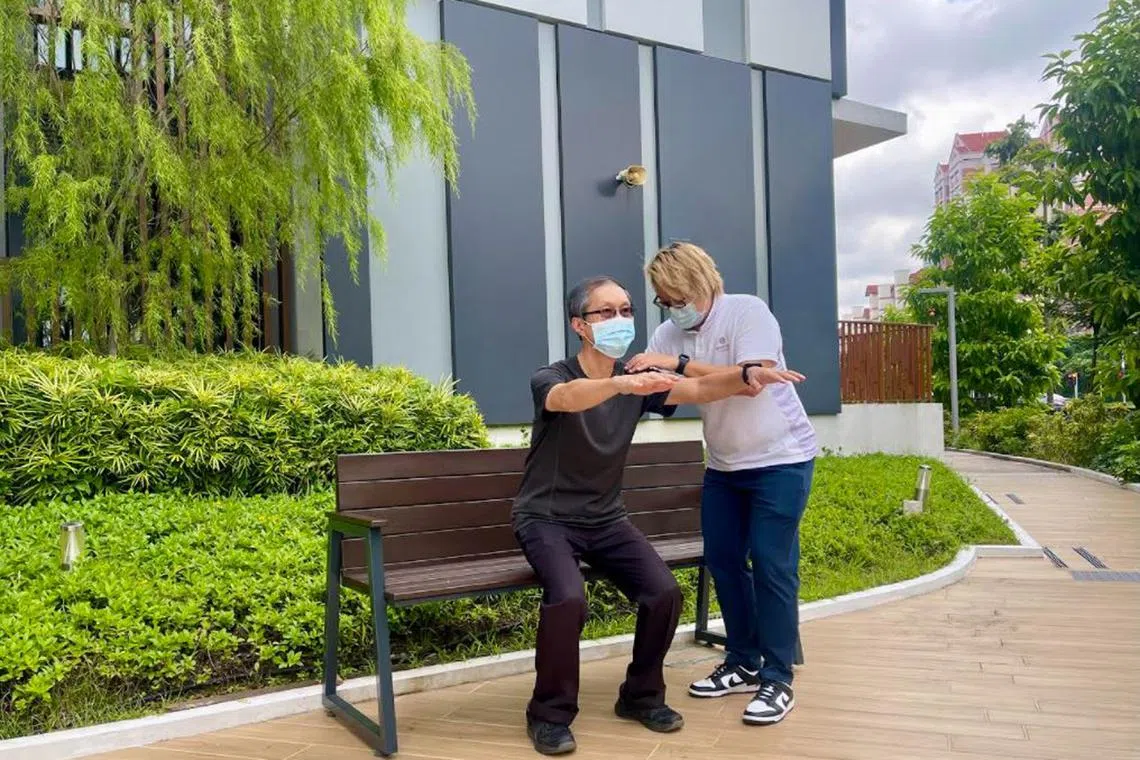
Each resident has his or her needs looked after by the Allium Healthcare team.
PHOTO: ALLIUM HEALTHCARE
Mr Bernie Poh, chief executive officer of Allium Healthcare, which runs Allium Care Suites, says the eldercare facility markets itself as “more household than nursing home”.
He recalls visiting a local nursing home 10 years ago and noticing a room near the rubbish collection zone. He found out it was a holding area for the nursing home’s residents who had recently died.
The memory has stayed in his head even after a decade, and he wants to create a senior home that dignifies ageing.
“You come in through the main door, you leave through the main door,” he says.
The facilities at Allium Care Suites do not come cheap. A month’s rent starts from $7,000 and increases depending on the type of room, and the amount of medical attention and rehabilitation services needed.
There is no shortage of takers, however. Since the facility opened in 2019, 80 per cent of the 129 beds have been filled up.
The company’s sales and marketing manager Jessyln Lau says she gets on average three to four requests daily to view the suites. Most are inquiring on behalf of their elderly parents or relatives. But increasingly, she also hears from seniors inquiring for themselves.
Mr Poh says: “We see family sizes becoming smaller, seniors are able to afford what they want. And they want options.”
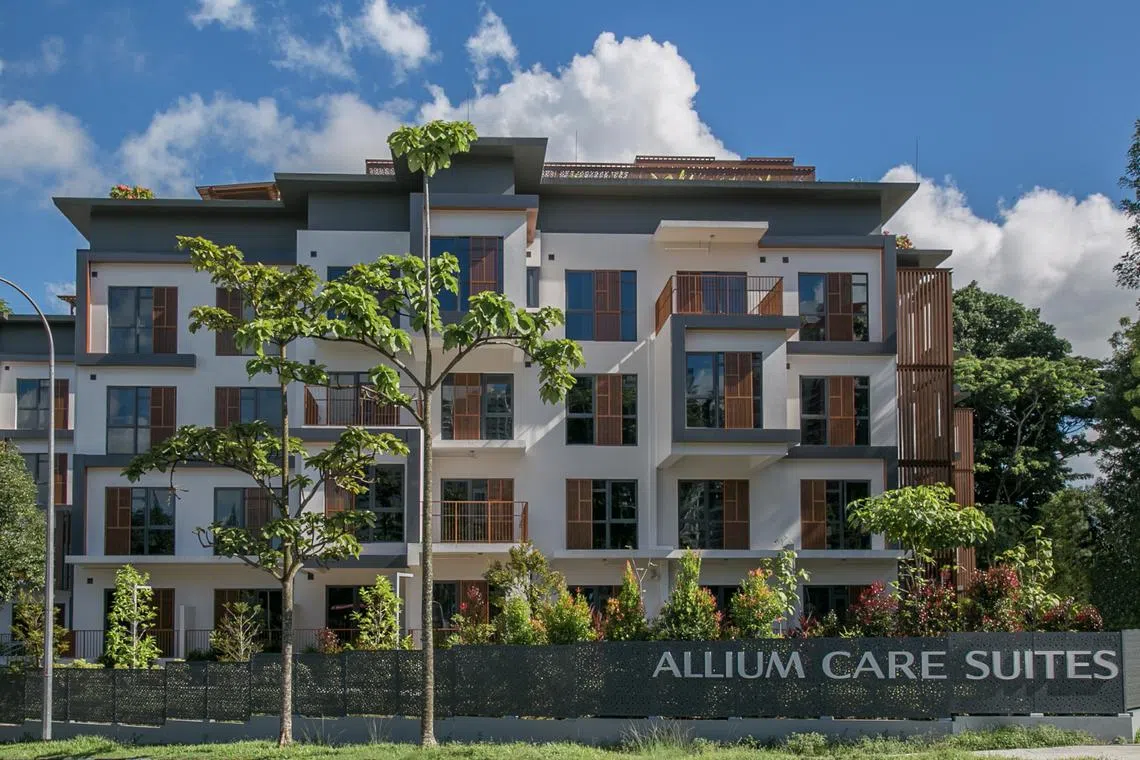
A month’s rent at Allium Care Suites starts from $7,000, and rises depending on the type of room and services needed.
PHOTO: ALLIUM HEALTHCARE
Community and government support
The reality, say experts, is that set-ups like Allium are beyond the reach of most seniors.
Public health researcher Nurul Hussain says: “Over time, it may not be sustainable to pay thousands of dollars a month, considering seniors are heavily relying on their retirement savings.”
“With our life expectancy at 83 years in 2022, I wonder to what extent seniors can continue to afford the high cost of care,” adds Ms Hussain, who works for the Saw Swee Hock School of Public Health.
Even $500 a month would be a stretch for Mr Eddie Khoo, 75, who lives alone in a one-room rental unit in Bedok South. The eldest son in a family with 11 children, he is not married and retired from his job as a safety coordinator 10 years ago.
He pays $111 a month for his flat which, despite a lingering smell of cigarettes, is clean. Minimally furnished, it has a single bed flush to one wall, a television set on a console and a couple of blue plastic chairs stacked up in a corner.
He suffers from a few chronic illnesses – diabetes, high cholesterol, hypertension and chronic kidney disease. Aside from the numerous medications he has to take daily, he goes to a nearby dialysis centre for a four-hour session thrice a week. He goes for these appointments by himself, travelling there using his personal mobility scooter.
His brother helps him with his rent, and payments for the bills for his doctor visits and medication are deducted from his MediSave. Every month, he gets a payout of around $360 from his CPF.
“Of course I am worried about money. If I have more, I will spend more. If I have less money that month, I will just eat bread at home,” says Mr Khoo.
To help seniors like Mr Khoo who are vulnerable to isolation, the Agency for Integrated Care (AIC) has set up a Silver Generation Office. Ambassadors are deployed to go door to door, engaging seniors living alone to better understand their struggles and connecting them with welfare services.
After a bad fall that resulted in a fractured hip and hospitalisation for a month, Mr Khoo was enrolled into Home Personal Care Plus, a programme under AIC to help vulnerable seniors who need some caregiving.
Under the programme, staff from Thye Hua Kwan Moral Charities help Mr Khoo with household chores every week. They also remind him to take his medication daily, and assist him to buy groceries and food.
Three sensors from fall detection and monitoring solution company RDI Home have also been installed in his living room, kitchen and toilet to alert the charity’s staff if he should have a fall or if there is a long period of inactivity.
Mr Khoo is thankful for the help. However, Dr Ramazanu wonders about the sustainability of this arrangement.
“Now we have volunteers and staff coming and supporting him on a weekly basis. By 2030, when more Singaporeans are aged, how will we ensure there are enough people to support the elderly, especially those in low-income families?”
Mr Khoo, who is reluctant to trouble his siblings and relatives, insists he can still take care of himself despite his deteriorating health.
“I prefer to be on my own. Why would I want to live in an old folks’ home? It’s like prison, I cannot smoke!” he says.
Dr Ramazanu is not surprised. “There are nurses and doctors to take care of you in a nursing home but from the perspective of a senior, the overall quality of life may not be there.”
She adds: “In most care organisations, there is a daily routine for patients to adhere to. For example, in a nursing home: 7am, shower time, 8.30am, breakfast. However, more needs to be done to incorporate personalised care to improve overall well-being and health outcomes for seniors.”
Need to reframe perspective
The issues surrounding eldercare are complex. Beyond the immediate concerns of housing and healthcare, there is a growing recognition of the need for holistic support that addresses the physical, emotional and social well-being of seniors.
Furthermore, studies have shown there is a discrepancy in access and awareness among different demographics, particularly among elderly men and minority groups. This disparity underscores the need to broaden outreach, and make information and resources accessible to all.
Prof Straughan says: “The (eldercare) market in Singapore is very bad. Because we are not prepared for ageing in Singapore. That’s the bottom line.”
The situation is not helped by the fact that talking about retirement homes and advance care planning is still taboo among many seniors and their family members.
“So when you don’t talk about them, you don’t prepare. Suddenly, we realise, we have a whole bunch of older folk who need care, and there’s no one to care for them,” says Prof Straughan.
Rather than looking at this eldercare problem pessimistically, she sees this as an opportunity to reframe Singapore’s perspective of an ageing population.
“We are going to grow old and we are going to live with disabilities. But is that necessarily the end of the world? We can plan an elder-friendly city, an eldercare landscape that allows us to continue to love living in Singapore even in our old age.”
Correction note: In an earlier version of the story, we said that the proportion of seniors aged above 65 who are single has increased from 4.9 per cent in 2010 to 6.3 per cent in 2020. This is incorrect. It should be from 4.6 per cent in 2010 to 7.2 per cent in 2020. We are sorry for the error.

